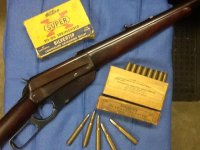DWalt
Member
"The 1906 round would fire in an original 1903 and the 1903 round would chamber in the 1906"
While the '06 round will fit and fire in the '03 rifle, the reverse is not true. Or shouldn't be. Aside from the case length, the real difference between them was that the .30-'03 cartridge had a different and heavier RN bullet and had much different external ballistics to the .30-'06 cartridge and spitzer bullet. Therefore, the rear sight of the .30-'03 rifle had to be changed to match the ballistics of the newer .30-'06 cartridge. Therefore, the Army purposely made the .30-'06 rifle chamber dimensions shorter so that the .30-'03 cartridge could not be used in it, only the .30-'06 cartridge.
While the '06 round will fit and fire in the '03 rifle, the reverse is not true. Or shouldn't be. Aside from the case length, the real difference between them was that the .30-'03 cartridge had a different and heavier RN bullet and had much different external ballistics to the .30-'06 cartridge and spitzer bullet. Therefore, the rear sight of the .30-'03 rifle had to be changed to match the ballistics of the newer .30-'06 cartridge. Therefore, the Army purposely made the .30-'06 rifle chamber dimensions shorter so that the .30-'03 cartridge could not be used in it, only the .30-'06 cartridge.

